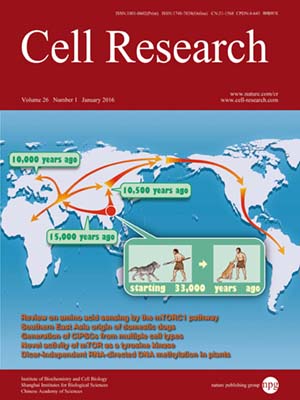
Volume 26, No 1, Jan 2016
ISSN: 1001-0602
EISSN: 1748-7838 2018
impact factor 17.848*
(Clarivate Analytics, 2019)
Volume 26 Issue 1, January 2016: 34-45
ORIGINAL ARTICLES
Pluripotent stem cells induced from mouse neural stem cells and small intestinal epithelial cells by small molecule compounds
Junqing Ye1,2,*, Jian Ge1,2,*, Xu Zhang1,2, Lin Cheng1,2, Zhengyuan Zhang1,2, Shan He1,2, Yuping Wang4, Hua Lin4, Weifeng Yang5, Junfang Liu1,2, Yang Zhao1,2,3 and Hongkui Deng1,2
1Shenzhen Stem Cell Engineering Laboratory, Key Laboratory of Chemical Genomics, Peking University Shenzhen Graduate School, Shenzhen, Guangdong 518055, China
2The MOE Key Laboratory of Cell Proliferation and Differentiation, College of Life Sciences, Peking-Tsinghua Center for Life Sciences, Peking University, Beijing 100871, China
3Department of Cell Biology, School of Basic Medical Sciences, Peking University Stem Cell Research Center, State Key Laboratory of Natural and Biomimetic Drugs, Peking University Health Science Center, Beijing 100191, China
4Department of Gynecology and Obstetrics, China-Japan Friendship Hospital, Beijing 100029, China
5BeijingVitalstar Biotechnology Co., Ltd., Beijing 100012, China
Correspondence: Hongkui Deng, E-mail: hongkui_deng@pku.edu.cn; Yang Zhao,(yangzhao@pku.edu.cn)
Recently, we reported a chemical approach to generate pluripotent stem cells from mouse fibroblasts. However, whether chemically induced pluripotent stem cells (CiPSCs) can be derived from other cell types remains to be demonstrated. Here, using lineage tracing, we first verify the generation of CiPSCs from fibroblasts. Next, we demonstrate that neural stem cells (NSCs) from the ectoderm and small intestinal epithelial cells (IECs) from the endoderm can be chemically reprogrammed into pluripotent stem cells. CiPSCs derived from NSCs and IECs resemble mouse embryonic stem cells in proliferation rate, global gene expression profile, epigenetic status, self-renewal and differentiation capacity, and germline transmission competency. Interestingly, the pluripotency gene Sall4 is expressed at the initial stage in the chemical reprogramming process from different cell types, and the same core small molecules are required for the reprogramming, suggesting conservation in the molecular mechanism underlying chemical reprogramming from these diverse cell types. Our analysis also shows that the use of these small molecules should be fine-tuned to meet the requirement of reprogramming from different cell types. Together, these findings demonstrate that full chemical reprogramming approach can be applied in cells of different tissue origins and suggest that chemical reprogramming is a promising strategy with the potential to be extended to more initial types.
10.1038/cr.2015.142
FULL TEXT | PDF
Browse 3403


